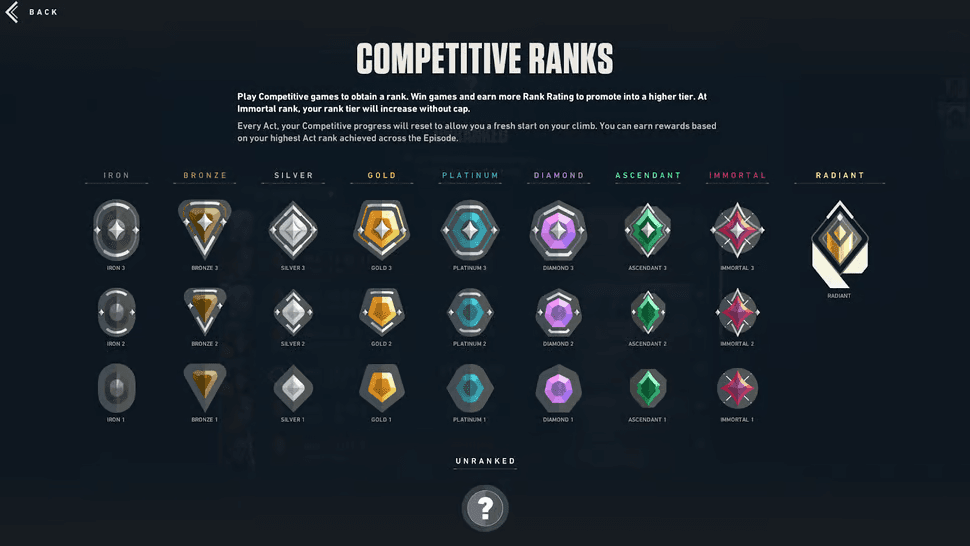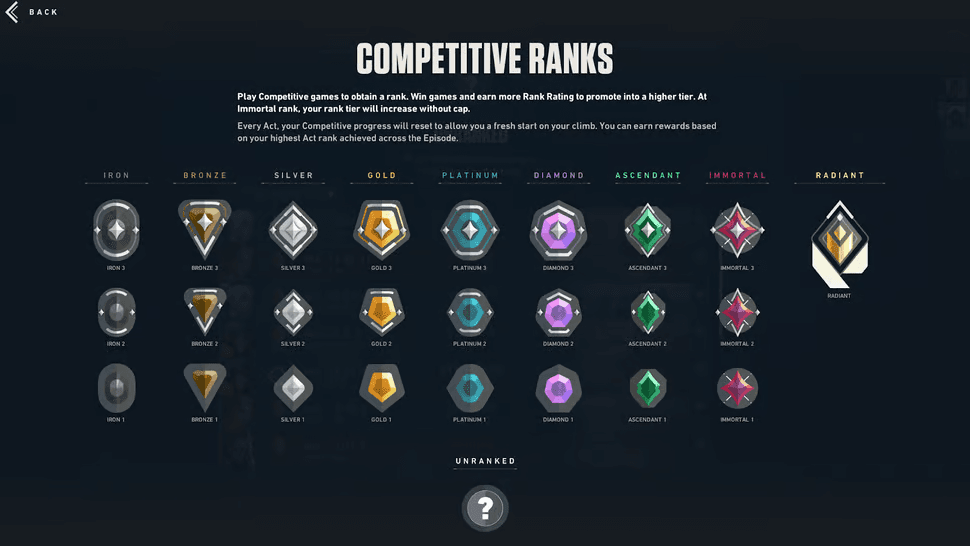


Do you play Valorant ranked and dream of reaching a higher rank?
If so, you need to know about the Valorant ranking system! The Valorant ranking system is a ladder of progression designed to represent a player's skill level in the game accurately.
The ranks, in ascending order of skill, are Iron, Bronze, Silver, Gold, Platinum, Diamond, Ascendant, Immortal, and the highest rank, Radiant.
Each rank, except Radiant, is further divided into three tiers – Tier 1 being the lowest and Tier 3 being the highest within each rank.
Placement matches, which you play at the beginning of your Valorant journey or the start of a new act, determine your initial ranking and these critical matches are your first step towards your Valorant ranking journey.
Your rank in Valorant is not just a reflection of wins and losses. It's a system influenced by your Match Rank Rating (MRR), Act Rank, and Ranked Rating (RR).
It's also worth noting that there's no rank decay in Valorant. To help you navigate the ranking system effectively, we'll cover those concepts in the following sections.
The Act Rank in Valorant is a unique system that provides a seasonal snapshot of a player's performance. Unlike the current rank, which fluctuates based on recent wins and losses, the Act Rank represents your highest sustained level of play during an Act.
Here's how it works: In each Act, Valorant players need to play 5 placement matches to set their initial rank. As you play more games, your Act Rank badge and rewards are determined by your 9 best wins and the peak rank you achieve in that Act.
In Valorant, the rank reset is a pivotal moment that marks the transition between competitive Acts. At the start of a new episode, players undergo a soft rank reset, meaning they must play a few placement matches to recalibrate their rank. This reset doesn't completely erase previous achievements but adjusts ranks to ensure the competitiveness remains fresh and accurate. It's an opportunity for players to demonstrate their improved skills or recover from past setbacks, making each Act a new chapter in their competitive journey. The rank reset ensures the ranking system stays dynamic, challenging, and fair.
But why is Act Rank important? It serves as a testament to a player's consistency and peak performance over a season. Unlike the current rank, which can be influenced by short-term fluctuations, the Act Rank is a more stable and enduring symbol of a player's capabilities. This encourages players to not only aim for high ranks but to sustain their performance to achieve a prestigious Act Rank by the end of the season.
In Valorant, your progression through the ranks is governed by two key metrics: Ranked Rating (RR) and Match Rank Rating (MRR). By understanding and focusing on these metrics, players can strategically work towards improving their game, leading to a more satisfying and successful Valorant experience.
The Ranked Rating (RR) Point is the more visible of the two, acting as a point system for ranking up or down. After each match, players gain or lose RR points based on the match outcome and their performance. The number of RR points needed to advance through the ranks or tiers varies, but the principle remains the same: perform well and win games to accumulate RR points and ascend through the ranks.
Match Rank Rating (MRR), on the other hand, is a hidden metric that operates behind the scenes. It's a sophisticated calculation that evaluates your skill level based on a variety of factors like kills, assists, economic efficiency, and more. MRR is crucial because it determines the level of opponents and teammates you are matched with. A higher MRR means you'll be placed in games with and against better players, which can lead to more challenging matches but also greater rewards in terms of RR gains for wins.
Ranking up in Valorant requires more than mechanical skill; it demands strategic thinking and effective teamwork. To climb the ladder:
And for that extra ranked push, why not check out our Valorant coaching service, built to help you climb those extra ranks?
Players in the Iron and Bronze tiers can queue with others up to the Silver rank. It allows newer or less experienced players to team up with those slightly more skilled, facilitating learning and growth.
Silver-ranked players can extend their matchmaking to include those in the Gold tier. This setup helps to bridge the gap between intermediate and more advanced skill levels.
Gold players have the opportunity to play alongside those in the Platinum rank. This combination offers a challenging yet rewarding experience for players who are honing their skills and strategies.
The restriction tightens for players ranked Ascendant and above, allowing them to invite only those in the Platinum rank or higher to their party. This ensures that the highest levels of play remain competitive and balanced, with players of similar skill levels competing against each other.
Many players harbor misconceptions about Valorant's ranking system. One common myth is that individual performance doesn't matter – in reality, it plays a significant role, especially in lower ranks.
Another misconception is that you need a high kill count to rank up. While kills are important, objective play and teamwork often carry more weight. Understanding these factors can change how you approach the game and your journey through the ranks.
Understanding the Valorant ranking system is a journey in itself. It's a complex yet great system that rewards skill and strategy. So, whether you're just starting or already climbing the ranks, remember that each match is a learning opportunity!